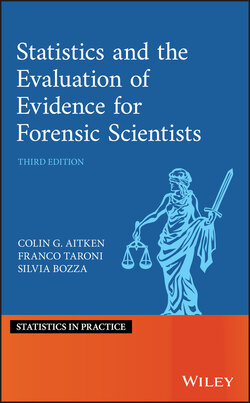Читать книгу Statistics and the Evaluation of Evidence for Forensic Scientists - Franco Taroni - Страница 30
1.7.5 Subjective Definition of Probability
ОглавлениеIn forensic science, it is often emphasised that there is a real paucity of numerical data, so that the numerical evaluation of evidence (Section 2.3.1) is sometimes very difficult. Examples of this difficulty are the numerical assessments of parameters such as transfer or persistence probabilities (see Sections 6.2.3 and 6.2.4) or even the relevance of a piece of evidence (see Section 6.3). The Bayesian approach considers probabilities as measures of belief (also called subjective probabilities) since such probabilities may be thought of as measures of one's belief in the occurrence of a particular event. The approach allows scientists to assign their probabilities, not only by certified knowledge and experience, but also by any data relevant for the event of interest, such as knowledge of an event that is often available in terms of a relative frequency. This specific relationship between relative frequency and probability is discussed in Section 1.7.6. Note that frequency is a term that relates to data and probability is a term that relates to personal belief.
Jurists are also interested in probabilistic reasoning using subjective probabilities, notably probabilities related to the credibility of witnesses and the conclusions that might be drawn from their testimony.
Any kind of uncertainty is assessed in the light of the knowledge possessed at the time of the assessment. This idea is not new. The Italian mathematician Bruno de Finetti (de Finetti, 1931a) defined probability – the measure of uncertainty – as a degree of belief, insisting that probability is conditional on the status of information of the subject who assesses it. So, if a given person, , say, is interested in the probability of an event, , say, that person's probability should be written as where is the information available to person at time .
Subjective probability may be found in many scientific areas (Press and Tanur 2001). In physics, for example, Schrödinger (1947) wrote
Since the knowledge may be different with different persons or with the same person at different times, they may anticipate the same event with more or less confidence and thus different numerical probabilities may be attached to the same event. (p. 53)
He then added that
Thus, whenever we speak loosely of the probability of an event, it is always to be understood: probability with regard to a certain given state of knowledge. (p. 54)
The same perspective is expressed by de Finetti in his famous sentence ‘Probability does not exist’ (in things) (de Finetti 1975, p. x). Probability is not something that can be known or not known, probabilities are states of mind, not states of nature. This aphorism can also be found in previous statistical and philosophical literature (i.e. de Morgan 1838; Jaynes 2003; Jevons 1913; Maxwell 1990). For example, Jevons (1913) wrote
Probability belongs wholly to the mind. This is proved by the fact that different minds may regard the very same event at the same time with widely different degrees of probability [ ,] Probability thus belongs to our mental condition, to the light in which we regard events, the occurrence or non‐occurrence of which is certain in themselves. (p. 198)
Probability is a fact about one's state of mind, not a fact about a phenomenon.
In summary, a person's assessment of their degree of belief (subjective probability) in the truth of a given statement or in the occurrence of an event (i) depends on information, (ii) may change as the information changes, and (iii) may differ from the assessment of others because different individuals may have different information or assessment criteria. In Savage's words (Savage 1954)
Probabilistic views hold that probability measures the confidence that a particular individual has in the truth of a particular proposition, for example, the probability that it will rain tomorrow. These views postulate that the individual concerned is in some way ‘reasonable’, but they do not deny the possibility that two reasonable individuals faced with the same information may have different degrees of confidence in the truth of the same proposition. (p. 3)
The only constraint in the assessment – as noted in Section 1.7.2 – is that it must be coherent. Coherence may be understood through consideration of subjective probability in terms of betting, for example, on the outcome of a horse race. For the probabilities on winning for each horse in a race to be coherent, the sum of the probabilities over all the horses must be 1. This property characterises a ‘reasonable individual’. An example is presented in Section 1.7.6.
For a historical and philosophical discussion of subjective probabilities and a commentary on the work of de Finetti and Savage in the middle of the twentieth century, see Lindley (1980), Lad (1996), Taroni et al. (2001), Dawid (2004), Dawid and Galavotti (2009), Galavotti (2016, 2017), and Zynda (2016).
Savage, like de Finetti, viewed a personal probability as a numerical measure of the confidence a person has in the truth of a particular proposition. This opinion is viewed with scepticism today and was viewed with scepticism then (Savage 1967), as illustrated by Savage (1954).
I personally consider it more probable that a Republican president will be elected in 1996 than it will snow in Chicago sometime in the month of May, 1994. But even this late spring snow seems to me more probable than that Adolf Hitler is still alive. Many, after careful consideration, are convinced that such statements about probability to a person mean precisely nothing or, at any rate, that they mean nothing precisely. At the opposite extreme, others hold the meaning to be so self‐evident [ ]. (p. 27)7
